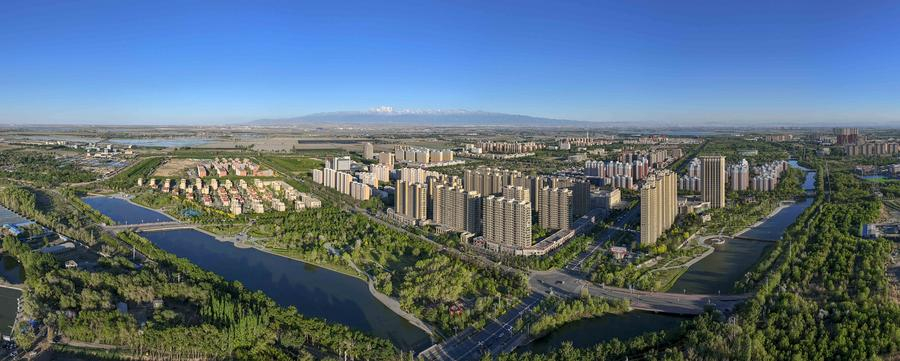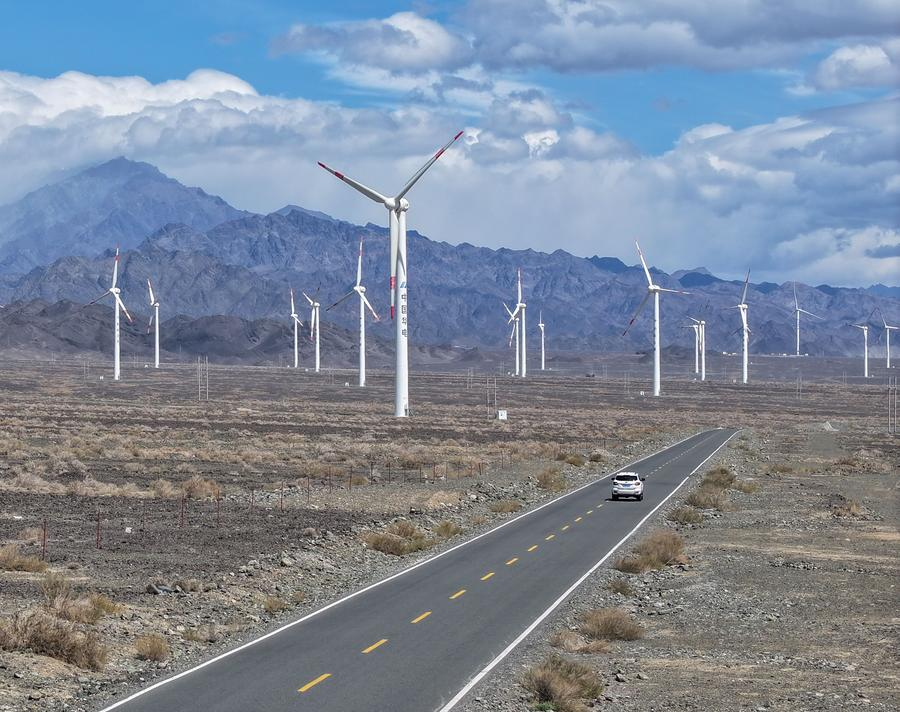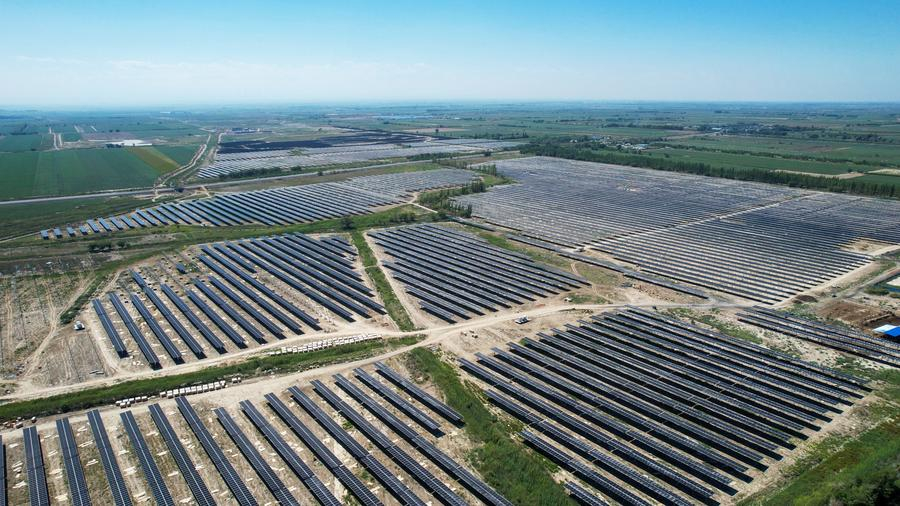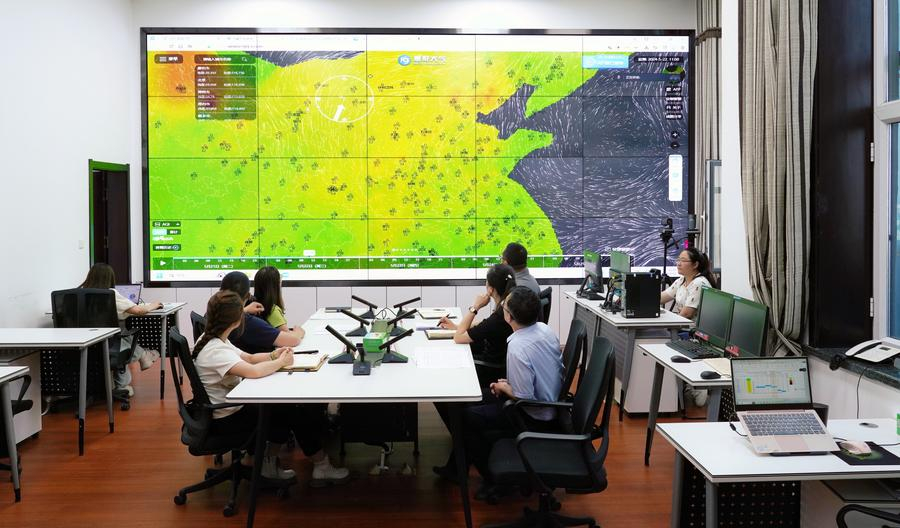Xinjiang's protection of blue skies shows China's determination to air-pollution control
* Located on the northern slope of the Tianshan Mountains, the economically vibrant Wu-Chang-Shi urban cluster contains Urumqi, parts of Changji Hui Autonomous Prefecture and the cities of Wujiaqu and Shihezi.
* For a long time, the cluster has been a key and challenging area for air-pollution prevention and control in Xinjiang due to its heavy industrial and coal-dominated energy structure. However, 2023 was the year with the most significant improvement in air quality in the past decade for the urban cluster.
* From Oct. 10, 2023 to April 10, 2024, Urumqi boasted 144 days of good air quality, an increase of 33 days year on year.
URUMQI -- Zhang Xin still remembers the complaints she saw on social media some years ago: "In winter, you can't see the sun clearly in the city of Urumqi," and "The snow is all black."
Zhang, who works in the ecology and environment bureau of Urumqi, capital of northwest China's Xinjiang Uygur Autonomous Region, used to participate in the air-pollution prevention and control work for a long time.
Urumqi is among an economically vibrant urban cluster located on the northern slope of the Tianshan Mountains, which also contains parts of Changji Hui Autonomous Prefecture and the cities of Wujiaqu and Shihezi. The urban cluster is collectively referred to as the Wu-Chang-Shi area by locals.
For a long time, Wu-Chang-Shi has been a key and challenging area for air-pollution prevention and control in Xinjiang due to its heavy industrial and coal-dominated energy structure.
However, 2023 was the year with the most significant improvement in air quality in the past decade for the urban cluster, thanks to the concerted and unremitting efforts made by the local ecology and environment authorities, enterprises and scientists.

An aerial panoramic drone photo taken on May 9, 2024 shows a city view of Wujiaqu, northwest China's Xinjiang Uygur Autonomous Region. [Xinhua/Hu Huhu]
The transformation of Wu-Chang-Shi is a microcosm of China's air-pollution control efforts. Following the introduction of an action plan to prevent and control air pollution in 2013, China became the first developing country in the world to impose large-scale efforts to reduce PM2.5 density.
China has announced that it will peak its carbon dioxide emissions by 2030 and achieve carbon neutrality by 2060.
IMPROVED AIR QUALITY
Years ago, the Chinese government began publishing air quality rankings in major cities, and the cities in Wu-Chang-Shi, such as Urumqi, often ranked at the bottom of the list.
"Surrounded by mountains on three sides, Urumqi has poor conditions for diffusion in both horizontal and vertical directions. According to an assessment, Urumqi's self-purification capacity in winter is only one-tenth of that in summer," said Zhang.
In winter, when temperatures often drop to minus 20 to 30 degrees Celsius, residents in Urumqi relied heavily on coal-fired heating, which led to more pollutant emissions.
Zhang said that with the central government funding, Urumqi has initiated projects, such as clean-energy heating. "The city has begun to improve its heating structure, from centralized heating and cogeneration to clean heating for all bulk coal users, which is a particularly effective experience in air-pollution control," she added.
In 2012, the central urban area of Urumqi completed the transformation from coal to gas for large-scale coal-fired heating boilers. In October 2023, the city completed the treatment of the remaining villages and households in rural areas that were using bulk coal for heating, making it among the first cities in China to achieve full coverage of clean-energy heating.

An aerial drone photo taken on April 25, 2024 shows a wind farm in Dabancheng District of Urumqi, northwest China's Xinjiang Uygur Autonomous Region. [Xinhua/Chen Shuo]
From Oct. 10, 2023 to April 10, 2024, Urumqi boasted 144 days of good air quality, an increase of 33 days year on year. The average concentrations of six major air pollutants, including PM2.5, decreased by 8.8 percent to 22.7 percent, reaching the best level since the monitoring began.
Social media, which acts as an unofficial "air quality monitoring station," also reflects the effectiveness of air-pollution control measures.
In recent years, Zhang noticed some positive changes on social media -- residents in Urumqi often post photos and videos of the blue skies of the city.
KEY INDUSTRIES, TARGETED MEASURES
Located in the city of Shihezi of the Wu-Chang-Shi area, Tianwei Cement Co., Ltd. is a major cement-producing company in the city.
China is among the world's largest producers and consumers of cement. However, due to factors such as large emissions during production, the cement industry is also a major contributor to carbon emissions.
In 2023, the regional government of Xinjiang proposed to spend three to five years to completely solve the air-pollution problem in Wu-Chang-Shi. Various departments have implemented pollution control measures in key enterprises in the area.
Tianwei Cement is among the 135 industrial enterprises in Wu-Chang-Shi that have been given priority treatment, which altogether account for more than 92 percent of the total pollutant emissions in the area.
According to the ecology and environment bureau of Shihezi, in terms of the comprehensive management of air pollution, the city has implemented a performance-based grading system of key industries to cope with heavy-pollution weather, in sync with other regions across China.

This photo taken on Aug. 22, 2023 shows a photovoltaic project in Shihezi City, northwest China's Xinjiang Uygur Autonomous Region. [Photo by Zhang Peng/Xinhua]
The four-tier grading system, involving 39 key industries including steel and chemicals, is a measure to implement differentiated control in response to heavy-pollution weather, with A representing the highest and D the lowest. When heavy-pollution weather occurs, Class-A enterprises can take measures independently based on their actual situations to reduce emissions without stopping or limiting production.
To attain the Class-A rating as quickly as possible, Tianwei Cement has collaborated with the city's ecology and environment bureau to develop a tailored pollution control plan. Measures have been taken during various processes of production, including the installment of dust-reduction devices in its warehouses.
Last year, the company obtained the Class-A rating after completing the ultra-low emission transformations. Thanks to the upgrades, the company made a profit of over 80 million yuan (about 11.34 million U.S. dollars) in 2023.
Meanwhile, Shihezi's air quality in 2023 reached the best level since 2017, data shows.
BUILDING TALENT BASE
Sitting in an office of the air-pollution prevention and control center of Changji, Ma Tong can oversee the pollutant emissions in the entire prefecture in real time through a large screen, which displays data and charts, such as the forecast and dynamic control of heavy-pollution weather. However, she still worries.
"A lot of data has been integrated into the platform, but the problem is how to effectively utilize it. We lack skilled personnel who can use the platform and information equipment," she said.

This photo taken on May 20, 2024 shows staff members working at an office of the air-pollution prevention and control center in Changji Hui Autonomous Prefecture, northwest China's Xinjiang Uygur Autonomous Region. [Xinhua/Aman]
Ma is an expert from the Chinese Research Academy of Environmental Sciences. Five years ago, she came to Xinjiang to provide intellectual support for local air-pollution control. "Changji is already at the forefront of Xinjiang in terms of air-pollution treatment through sci-tech means, but compared with the whole country, the prefecture lacks equipment and talent," said Ma.
Since last year, the regional government of Xinjiang has pooled 10 billion yuan in funding to establish the Xinjiang talent development fund, which is used to introduce talent from other parts of China, among other objectives.
In early 2024, the Urumqi-based Xinjiang University introduced Huang Haibao, an air-pollution control expert from Sun Yat-sen University in south China's Guangdong Province.
"In addition to cultivating talent ourselves, we have also introduced a group of scholars from universities including Beijing University of Chemical Technology," said Huang.
Within six months, Huang and his colleagues have established the air-pollution control and research center at the university. He is working to establish the Xinjiang environmental science society, which will serve as a gathering place for the top scientific research talent in Xinjiang and a platform for international cooperation and exchange.
He also stresses the importance of collaboration between academia and industry. "Ultimately, emission reduction needs to be implemented at the enterprise level," he said, adding that his team has visited over 10 companies to strengthen cooperation in terms of technology and scientific research.
"We will try to bring in the technologies, talent and companies from across the country to contribute to air-pollution prevention and control work in Xinjiang," he said.
Video reporters: He Jun, Aman and Zhang Xiaolong; Video editors: Liang Wanshan, Roger Lott, Li Qin and Zhang Qiru
























